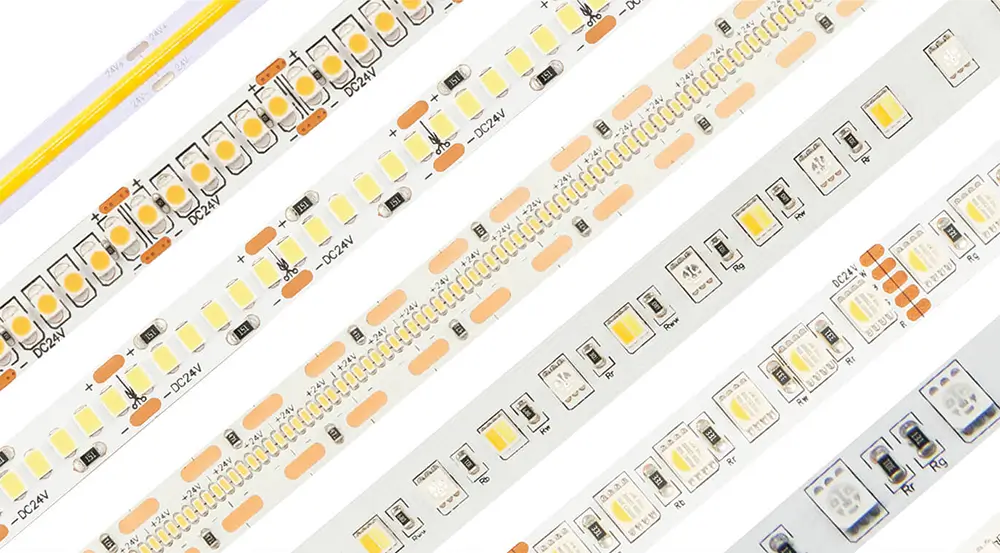
LED strip lights are available in a variety of sizes and widths. The common widths are 8mm, 10mm, and 12mm. But there are also special LED strip board widths: such as 4mm, 6mm, 15mm, 20mm, etc. Therefore, when choosing the LED strip, you also need to consider the widths of the LED strip lights. Because if it’s too wide, you won’t be able to fit the fixture into a narrow space. LED strip light widths are a key consideration.
As we know, the widths and size of the LED strip lights will affect their appearance and function. Next, let’s discuss the widths of LED strip lights and how to choose the correct width of LED strip lights.
What are the Widths of the LED Strip Lights?
LED strip width refers to the width or thickness of the LED strip. In many lamps, LED light strips are installed inside. Therefore, the width of the LED strip is basically the width of the PCB. Usually measured in millimetres (mm) or inches (inch). Different LED light strips come in different sizes, but the most common widths are 8mm, 10mm, and 12mm.
Single-Row LED Strip Lights
Single-row LED strip lights are usually 8mm, 10mm, or 12mm, and they are also the three most widely used widths. Of course, there are other widths such as 4mm, 6mm, etc.
Multi-Row LED Strip Lights
LED strip lights also have double rows and three rows or more, and the width can reach 28mm. As the number of rows increases, the widths of the LED strip lights will also increase. However, this also depends on the size of the chip or SMD.
Why Is It Important to Consider LED Strip Lights Widths?
Given the usability of the lighting, it is crucial to consider the width of the LED strip in advance, affecting the aesthetics and functionality of its application. Here are some key reasons why LED strip width is so important:
Suitability for installation
The width of your LED strip will affect the ease of installation. In different projects, we need LED strip lights of different widths. For example, wider strips may be easier to handle and install, while narrower strips may be more challenging, especially in complex or tight spaces. But the most important thing is to look at the installation location, whether it is suitable for a wider LED strip or a narrower LED strip.
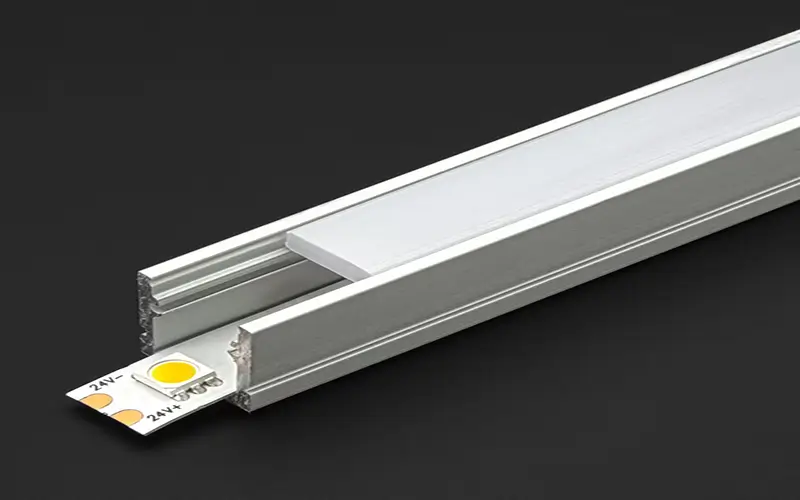
Efficient heat dissipation
The LED strip will generate heat, and the width of the light strip will directly affect its ability to efficiently dissipate heat. Wider LED strips generally have more surface area for better heat dissipation. Narrow LED strips do not dissipate heat as quickly and require auxiliary heat dissipation. This is an important consideration to ensure the longevity and optimal performance of the LED.
Brightness light distribution
The width of the LED strip lights affects the light distribution problem. Wider strips provide more even lighting over a larger surface area, while narrower strips create focused or accent lighting. So, you need to consider the intended use and lighting requirements of the space. This way you can choose the right width LED strip lights.
Flexibility
The width of the LED light strip affects the flexibility of the light strip. Different applications may require more or less flexibility depending on the contours and shape of the surface on which the LED strips are mounted. Narrower strips may be better suited for intricate designs. Wider LED strip lights are not suitable for such a design.
Energy Consumption
The width of the LED strip affects power consumption. Wider strips may require more power to achieve a certain brightness level. Narrow LED light strips must have low power, while wider LED light strips must have higher power. So understanding the power requirements is crucial to choosing an energy-saving solution that suits your needs.
Aesthetic Appeal
The width of LED strip lights determines how seamlessly they blend into various spaces. Choosing the correct width ensures a clean, aesthetically pleasing installation that complements the design of the area where the LED strip light will be applied. So be sure to choose the appropriate LED width.
Common LED strip widths
The width of each LED strip varies, depending on production and design. However, the width also depends on the type of LED strip you are using and the size of the LED chips. Below, we have analyzed the dimensions of the following conventional light strips for your reference.
How Are Wides the 5050 LED Strip Lights?
5050 LED light strip uses 5050 SMD LED, and the size of 5050 SMD LED is 5mm x 5mm. 5050 LED lights can display white, red, green, blue and other single colors or RGB and RGBW colors.
The 5050 series led strip is generally 10mm wide, and there are also 12mm. Double-row 5050 light strips are also available, and the double-row 5050 light strips have a width of 15 mm. In addition, the 5050 RGB series has a maximum width of 20mm, and the 5050 RGBW LED strip lights series has a maximum width of 20mm.
5050 is the most conventional light strip, so you need to choose the light strip you want based on your project. Then, you need to know. The more LEDs on a light strip, the more energy is consumed, the higher the wattage of the power supply to drive the LED light strip, and the more expensive the cost.
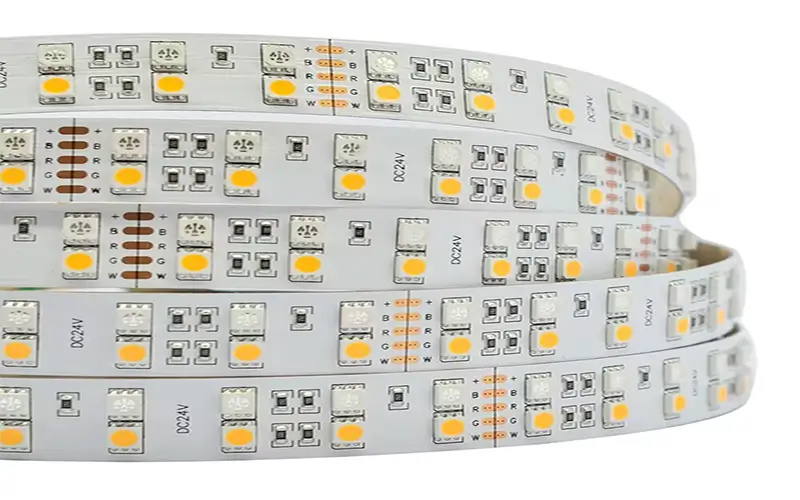
How Are Wides the 2835 LED strip lights?
2835 SMD LED strip lights are available in single-row or double-row light strips. The conventional ones are 8mm plate type and 10mm plate type, these two are the most chosen by customers.
Among them, 5mm and 6mm LED strip lights are narrower LED light strips, and more attention should be paid to the heating problem of LEDs. You can add aluminum profile accessories to the narrow light strip to enhance LED heat dissipation and avoid damage to the light strip due to heat accumulation.
Of course, 8mm and 10mm widths LED strip lights are the most popular. For example, 2835 120leds/m and 240leds/m are high-density and high-power LED light strips.
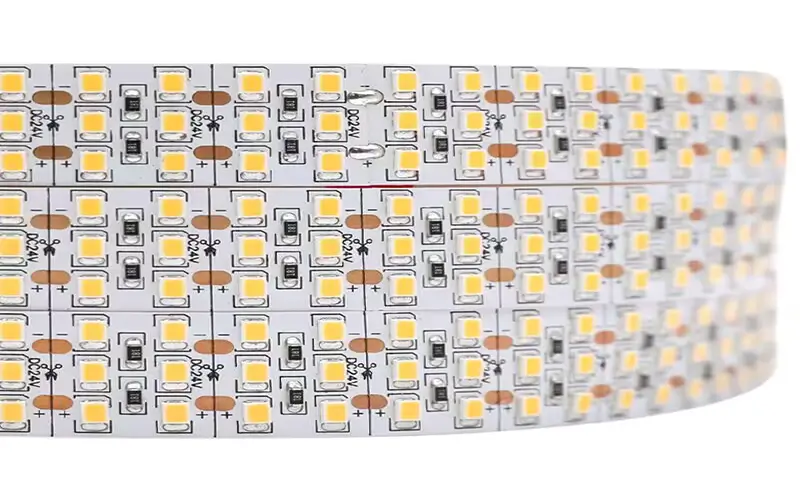
How Are Wides 3528 LED Strip Lights?
The 3528 LED measures 3.5mm x 2.8mm and consumes less power than the 5050 SMD LED at only 0.08 watts. 3528 single-row LED strip is 8mm or 10mm, which is also the most popular style.
Similarly, there are also the narrowest light strips 5mm and 6mm, which are mainly used in narrow spaces.
Of course, the width of the double row 3528 LED light strip is 15mm. The three rows of 3528 light bars are 20mm wide. The four rows of 3528 light bars are 28mm wide.
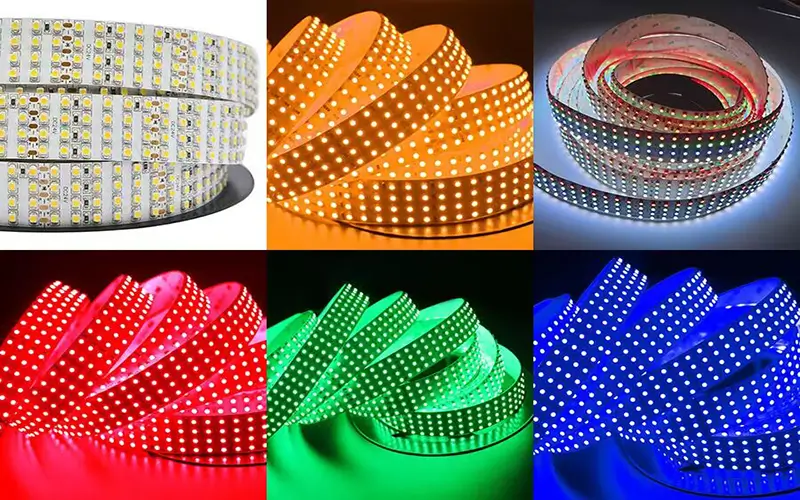
Does LED Strip Width Matter?
For spacious installation sites, the width of the light strip is not very important. In contrast, the density and brightness of LEDs require more attention, because large places usually require higher brightness to illuminate details. LED strip width is only critical where width is a constraint.
Another point is that many lighting projects usually install LED light strips in LED aluminum profiles. If you want to add silicone LED diffusers or aluminum LED channels to your strip to get even, soft linear light, you have to consider whether their internal width matches your PCB width. You can’t fit a 12mm wide LED strip through a 10mm internal width silicone diffuser, nor can you fit it into a 10mm internal width aluminum channel.
The widths of other best-selling LED strip lights are provided below for your reference.
| Types of LED Strip Lights | LED Strip Width |
| COB LED Strip | 4mm, 8mm, 10mm, 12mm |
| 2110 LED Strip | 3mm, 4mm, 8mm, 10mm |
| 2216 LED Strip | 3mm, 4mm, 5mm, 10mm, 12mm |
| 3014 LED Strip | 5mm, 8mm, 10mm |
| 5630 LED Strip | 10mm, 12mm, 15mm |
Narrow Vs. Wide Widths LED Strip Lights, How to Choose?
The application of LED strips, whether narrow or wide, depends on various factors, including the specific lighting needs, the design of the space, and the desired visual effects. Here’s a breakdown of the applications for narrow and wide-width LED strips:
Narrow Widths LED Strip Lights Application
Accent Lighting: Highlighting architectural features, artwork, or specific elements in a space. Narrow strips are ideal for creating subtle accents and emphasizing particular details without overpowering the overall lighting.
Cove Lighting: you can install LED strips in recesses or ceiling, such as along the top of cabinets or within ceiling coves. The narrow width allows for discreet placement in confined spaces, providing indirect and soft illumination.
Signage and Lettering: Backlighting letters or creating illuminated signage. The narrow profile allows for precise outlining of letters and shapes, creating a visually appealing and attention-grabbing effect.
Task Lighting: Under-cabinet lighting in kitchens or task lighting in workspaces. Narrow strips offer focused and directed lighting, making them suitable for applications where specific tasks need to be illuminated.
Flexible Designs: Wrapping around curves, bends, or irregular shapes. The flexibility of narrow strips makes them suitable for installations in tight or intricate spaces where a wider strip might be less adaptable.
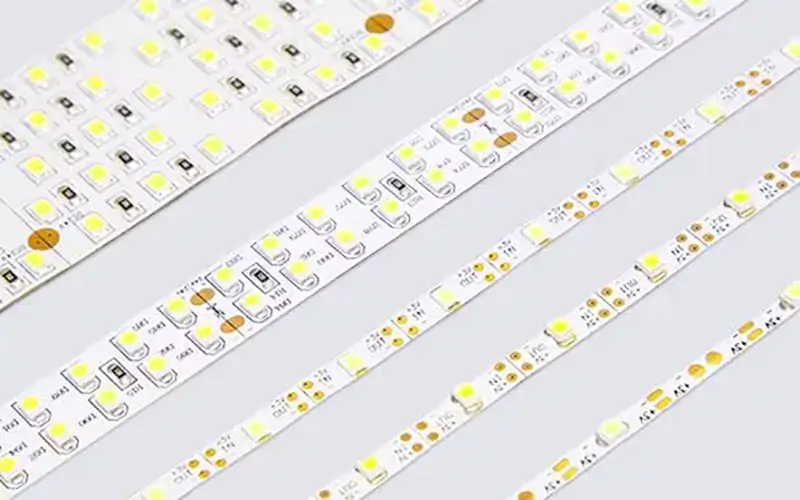
Wide Widths LED Strip Lights Application
Architectural Lighting: Illuminating large architectural features, such as walls or columns. Wide strips can cover more surface area, ensuring even lighting and enhancing the visual impact of architectural elements.
General Ambient Lighting: Primary lighting in living rooms, bedrooms, or offices. Wide strips provide broader and more uniform illumination across larger areas, making them suitable for general ambient lighting.
Commercial Spaces: Retail displays, showcases, or lighting in commercial establishments. Wide strips can deliver bright and consistent lighting, enhancing visibility and attracting attention in commercial settings.
Backlighting: Backlighting larger panels, screens, or displays. Wide strips can evenly backlight larger surfaces, providing uniform illumination without visible hotspots.
Linear Indirect Lighting: Placing LED strips along the perimeter of a room for indirect ambient lighting. Wide strips create a more diffused and softer light, suitable for creating a cozy and inviting atmosphere.
In conclusion
In summary, the widths of LED strip lights are a key factor affecting their performance, appearance, and suitability for a specific application. When you choose an LED light strip, you need to carefully consider the width as well as other factors such as brightness, color temperature, and flexibility to ensure that the LED light strip you choose meets the requirements of the intended lighting project. We are a manufacturer of LED led strip. If you have any needs, please contact us.
FAQs
First of all, you have to consider the location and environment where the LED strip is installed. Secondly, you need to consider factors such as the application (accent lighting, ambient lighting, etc.), the size of the space, and the required visual effects. In addition, there are also aspects such as cost budget and light strip heat dissipation.
Simply put, wider light strips generally provide a more even light distribution over a larger area, while narrower light strips produce more concentrated lighting. So you need to make the best choice based on your lighting project.
It is possible, mainly because it is installed at that location. If it is a narrow place indoors, you can only use narrow LED strip lights. But wider LED strips are better for general indoor lighting because they provide wider coverage and even lighting.
Narrow LED strips are more flexible, so they are better suited for wrapping around curves or fitting into tight spaces. And wide light strips cover more surface area, ensuring uniform lighting and enhancing the visual impact of architectural features.
This will indeed have an impact, but not directly. Wider LED strips typically have a larger surface area, which facilitates better heat dissipation and helps extend the life of the LED. The heat dissipation function of narrower LED light bars will be worse than that of wide light bars, so other accessories must be used to assist heat dissipation, so as to ensure longer use time.
